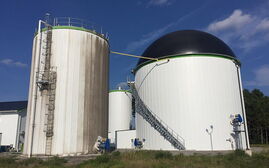Year in review: uncertainty but big wins in 2012
 photo/Courtesy ORPCphoto/TIM GREENWAYphoto/DARREN FISHELLphoto/Courtesy MRRA
photo/Courtesy ORPCphoto/TIM GREENWAYphoto/DARREN FISHELLphoto/Courtesy MRRA
Headlines in 2012 were dominated by political news as we re-elected a president, sent a familiar face to Washington and watched as the State House turned more blue than red.
Politics retains its stranglehold on headlines as anxious executives wait to see what Congress will do to avoid a year-end fiscal cliff and nervous markets respond to each new rumor and the shifting economies in Europe and elsewhere.
Political leaders at an international convention in New Brunswick touted energy as a key cross-border economic issue in October just as groundbreaking tidal technology made North American history in waters between northern Maine and that Canadian province. The 176,000 pilot tidal power project from Portland-based Ocean Renewable Power Co. began pumping power to the grid through a landmark purchasing agreement with Bangor Hydro Electric in September.
But here at home, there was remarkable business news that didn't dominate headlines, but had a tangible impact nonetheless. Some companies attracted significant capital investment (Putney Inc., Cate Street Capital and CashStar among them) while others welcomed mergers to enhance resources (Sage Data Security) and others broadened their own portfolios through acquisitions (WEX Inc., Cross Insurance and Camden National were standouts.) Several organizations changed top leadership, a summary of which appears on page 11.
But where was impact on Maine's business sector most defined? That's the question we asked ourselves as the Mainebiz editorial team sat down to review 2012. You'll see our four picks — two industry sectors, one development and a list of impressive construction projects — starting below.
-Carol Coultas, editor
Energy
From tidal power to natural gas, energy was a charged topic throughout 2012 in Maine.
Falling prices for natural gas stalled wind power, Maine's most highly developed and commercially available renewable energy resource, and they began to undercut prices for other sources of electricity as well. But how long those lower natural gas prices might last is unclear.
Political leaders at an international convention in New Brunswick touted energy as a key cross-border economic issue in October just as groundbreaking tidal technology made North American history in waters between northern Maine and that Canadian province. The 176,000 pilot tidal power project from Portland-based Ocean Renewable Power Co. began pumping power to the grid through a landmark purchasing agreement with Bangor Hydro Electric in September.
That project put into action another renewable energy source that can fulfill a requirement that Maine power companies generate a certain percentage of their power from renewable sources.
Renewable power sources like solar and wind continue to forge ahead to test new markets, they continue to chase "grid parity," or prices that can compete with other electricity generation methods like burning coal and natural gas that continued to drop through 2012. The cost differential set the stage this year for political attacks on the state's renewable source requirement — called Maine's Renewable Energy Portfolio standard — for which Gov. Paul LePage said the cost of compliance is too high.
The cost of renewable power also became an issue for Kenneth Fletcher, head of the Governor's Energy Office, in relation to a proposal by Norwegian energy company Statoil for an offshore wind energy project in the Gulf of Maine. Fletcher questioned whether the upfront costs for the project would pay off long-term for the state and in October asked the company for more specific details on its proposal.
Late in the year, Fletcher's office received separate bids from Nova Scotia-based Emera Inc. and from British firm Grid National for the ability to use the I-95 and I-295 corridors to transmit electricity.
Other energy developments:
- Wind power: Despite dropping natural gas prices slowing demand for growth in renewable sources, wind power projects completed this year included First Wind's 19-turbine Bull Hill wind farm and plans for further developments near Bingham and at Bowers Mountain.
- Wholesale energy: Seeking near-term cost savings on energy, Maine's wholesale energy market became much more crowded this year after Electricity Maine's debut brought the competitive rate energy provider 150,000 customers in just one year. Four other companies announced entering that market in late 2012, including: South Portland-based Dead River Co.; Paris-based C.N. Brown Co.; Massachusetts-based Gulf Oil, as subsidiary Gulf Electricity; and North Carolina-based FairPoint Communications, as subsidiary FairPoint Energy.
- Natural gas: Dropping prices also fueled competition for natural gas developments in the state amplified by a fight between Maine Natural Gas and Summit Natural Gas of Maine over a state natural gas contract and Augusta area clients as part of a push to build out natural gas infrastructure throughout the Kennebec Valley. In the northern part of the state, Montana-based Gas Natural Inc., as Penobscot Natural Gas Co., acquired a $4.5 million lease for the 189-mile Loring pipeline, which it plans to use to distribute natural gas to residential and commercial areas without natural gas service.
Energy: What to expect in 2013
- Thermogen Industries LLC is investing $66 million to build a plant using new technology to generate "biocoal" — or torrefied wood — from wood waste from the East Millinocket paper mill. It plans to open its biocoal plant in fall 2013.
- Expiration of federal subsidies for wind farms this year could slow development in 2013.
Energy: What didn't happen in 2012
- DCP Midstream's plans for a 23-million-gallon liquid propane tank in Searsport will depend on a local decision to come in January 2013.
- TransCanada's plans to expand its 44-turbine wind power development at Kibby Mountain to neighboring Sisk Mountain remains a concept as opponents in November lobbied a legal challenge to a state review that approved the project.
-Darren Fishell, online editor
Transportation
Maine ports grabbed the spotlight in 2012 as they received over $25 million in investments. From the country's easternmost city to the eponymous Portland, new opportunities and equipment have helped Maine ports prepare for importing and exporting opportunities while maintaining a focus on the local market.
Ports
- Eastport leads the way: The country's most easterly city has an Old West feel thanks to a deal with a Texas-based cattle company that has shipped more than 20,000 livestock through the port since the summer of 2010.
- Livestock shipping was made possible after the port received temporary approval from the U.S. Department of Agriculture, making it the only New England port authorized to do so. Chris Gardner, Eastport Port director, says the port has renewed its temporary agreement to ship livestock, and plans to continue the service.
- But cattle aren't the only growth market for the port. After a 2009 scare when it looked like the port might lose its biggest customer in Baileyville's Woodland Mill, port officials identified exporting woody biomass to the European market as a promising opportunity and secured funding to expand in that direction. In 2012, the port unveiled a bulk cargo handling system, an $8 million investment that created new loading space, a warehouse and a belt conveyor system that woodchip exporter Timber Biofuel Venture has already taken advantage of.
- Auburn industrial park expansion: The Auburn Intermodal Transfer Facility moves more tonnage than any other port in the state, and stands to keep making gains as work continues on the nearby Auburn Industrial Park. In April, the city received another $1.7 million to help fund the project, which officials say could create 1.3 million square feet of space and attract up to $80 million in private investment.
- Bar Harbor sets cruise ship record: The port saw a record number of cruise ship visits this year, with 108 vessels docking at the tourist hotspot over the summer, up from just 22 two decades ago. Next year also looks promising, with 135 visits scheduled.
- Megaberth hits milestone: Portland's $6 million deepwater megaberth was put to use for the first time this year, hosting Royal Caribbean's 990-foot, 2,000 passenger "Enchantment of the Seas" on Sept. 8. The port saw 58 cruise ships passed through Casco Bay in 2012, bringing roughly 65,000 passengers to the city.
- Portland container service ends: Dormant for four years following the departure of its last client, Portland's International Marine Terminal welcomed startup shipping company American Feeder Lines to the Commercial Street facility in summer 2011. A recent $5 million influx allowed for an extra 5,000 square feet and the doubling of the pier's weight capacity, but it was not enough for American Feeder Lines, which in May abruptly ended container service, citing weak demand and a loss of private investment. A $150,000 grant to help the Maine Port Authority introduce a new energy-efficient tug boat could help spur the container shipping business.
Roads
- East-West highway study stalled: In February, Sen. Doug Thomas, R-Ripley, sponsored a bill supporting a $300,000 feasibility study for a four-lane, 230-mile highway from Calais to Coburn Gore. Cianbro Corp. CEO Peter Vigue quickly became the private-sector face of the effort, estimating a cost between $1 billion and $2 billion through a public-private partnership. Plans to conduct the feasibility study were slowed by Gov. Paul LePage in August, one day after Thomas announced plans to suspend the study, citing opposition from private citizens. Earlier this month, the project was panned in a Sierra Club national report.
- New turnpike tolls: The Maine Turnpike Authority approved new E-ZPass toll discounts for regular turnpike commuters while raising cash rates in October. The rate revision includes a 50% discount for commuters making 40 or more one-way trips per month and a 25% discount for commuters making between 30 and 39 one-way trips. Those discounts were approved for up to eight months, and started on Nov. 1.
Airports
- Jetport expansion: The Portland International Jetport unveiled a $75 million terminal expansion, adding an elevated sky bridge, boarding pass kiosks and an expanded security checkpoint. Southwest Airlines has also announced plans to take over flights out of the jetport currently operated by its subsidiary AirTran early next year. A Portland-based startup airline, Elite Airways, has also announced tentative plans to offer non-stop flights to the west coast of Florida, which is the third largest destination for jetport travelers.
Transportation: What to expect in 2013
- A decision on LNG terminal in Searsport. First proposed by Colorado-based DCP Midstream in 2009, the idea of constructing a $40 million, 22.7 million-gallon liquid natural gas tank in Searsport was met with local resistance. In May, the town voted 297 to 165 against a proposed moratorium that would have slowed or possibly derailed the project, and in late November, the Searsport Planning Board held four days of public hearing on whether the tank would meet land-use rules. The latest kink in the project? With the Northeast now awash in cheap, domestic propane, some suspect that the tank could be better utilized to export rather than import LNG.
- The return of the CAT. Eyeing the second of its alloted nine lives, the Nova Scotia-to-Portland ferry service known as the CAT made headlines in 2012 after Nova Scotia Premier Darrell Dexter expressed interest in restarting the ferry service. Dexter cited a government report that suggests the ferry could break even within seven years if provided with $5 million in startup funds and $21 million from the province to cover operating losses. So far four companies, including former CAT operator Bay Ferries Ltd., have expressed interest in preliminary discussions of the ferry service contract
Transportation: What didn't happen in 2012
- An East Coast dock strike. A potential strike from a union representing 14,500 longshoremen threatened container shipments to Portland and other major East Coast ports late this summer, leading some Maine retailers to develop contingency plans in the event of such a strike. In late September, the International Longshoremen's Association and the US. Maritime Alliance reached an agreement to extend negotiations past an Oct. 1 deadline to Dec. 29 during a meeting with a federal mediator.
-Matt Dodge, staff writer
MRRA
Midcoast Regional Redevelopment Authority's year began with a thud. Just 16 days into 2012, its highest-profile prospective tenant, Kestrel Aircraft Co., announced it was leaving for Wisconsin, taking with it 300 to 600 manufacturing jobs. The jobs would have been based at Brunswick Landing once the startup company began making airplanes inside MRRA's premier asset, a state-of-the-art 170,000-square-foot hangar built by the Navy in 2004.
Wisconsin had given Kestrel an offer it couldn't refuse — a financing package worth more than $100 million in tax credits, loans, allocations and a transfer of land in Superior, Wisc. By comparison, Maine had offered an incentive package of $10 million in tax revenue bonds backed by MRRA, a $4.75 million loan guarantee from the Finance Authority of Maine, property tax exemptions and help from an unnamed private investor.
As disappointing as that setback was, John Moncure, chairman of MRRA's board of directors, sees many important milestones fulfilled in the redevelopment effort's master plan. "We keep plugging away, we keep working to attract businesses to Brunswick Landing," says Moncure, a Topsham lawyer specializing in business and commercial real estate law. "Obviously, it's a marathon, not a sprint."
Milestones
- Foreign trade zone designation by U.S. Department of Commerce: The Brunswick landing foreign trade zone is particularly advantageous to biomedical, aviation and alternative energy manufacturers — three niche industries identified in the master plan as strong redevelopment prospects. An immediate beneficiary is Mölnlycke Health Care, a Swedish manufacturer of surgical and wound care products that are sold worldwide. Its $14.5 million production plant, which is nearing completion and will be outfitted with more than $34 million of new equipment, is slated to open in February and initially will be staffed by 45 workers.
- Tax incentive: Brunswick's Town Council approved a tax increment financing agreement linking job creation with a portion of tax revenues diverting back to Mölnlycke, allowing that money to be spent on defraying the company's costs of developing the site. The town's share of TIF revenues will be dedicated to infrastructure improvements and other town needs.
- Electricity agreement: Signed with Constellation NewEnergy through the Maine PowerOptions consortium, the agreement provides 100% "green energy" at a lower-than-market rate of about 9 cents per kilowatt hour to businesses at Brunswick Landing.
- Housing sales: The sale of Navy-owned land underneath approximately 700 former military housing units to developer George Schott for $3.35 million allowed his company, Affordable Midcoast Housing, to begin selling homes at prices ranging from $100,000 to $150,000. By year's end, 28 housing units had been sold and upwards of 80% of other units in Brunswick and Topsham were occupied by renters.
- Job creation: MRRA's job creation tally, according to the 2012 report card compiled by MRRA Executive Director Steve Levesque, is 150 employees working at 22 businesses. More than 500 new jobs and $150 million in new investments are expected to be made at Brunswick Landing in the next three years.
MRRA: What to expect in 2013
- A legal disagreement with Brunswick over the town's decision to tax property that MRRA believes is tax exempt under a state law relating to aeronautical uses simmers. Moncure says MRRA might seek a declaratory judgment from the courts regarding the conflicting interpretations of Maine's law.
MRRA: What didn't happen in 2012
- Gov. Paul LePage's decision to hold off on issuing $40 million in authorized bonds that would have funneled $2.9 million to MRRA and was expected to leverage almost $2 million in matching federal grants. The money was to be used on improvements to bring former Navy buildings into compliance with current building codes. LePage is obligated to issue the bonds before January 2014; whether federal funds will still be available is uncertain.
-James McCarthy, senior writer














Comments